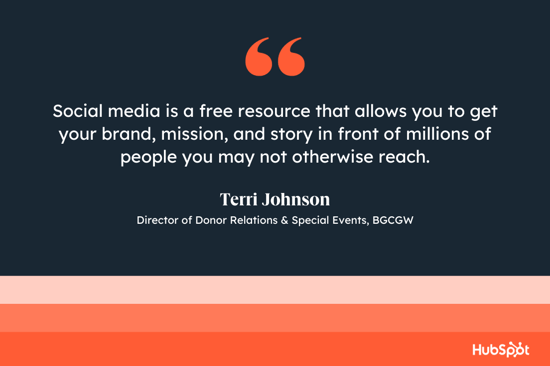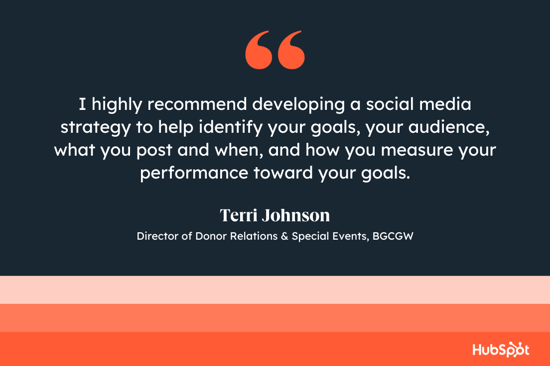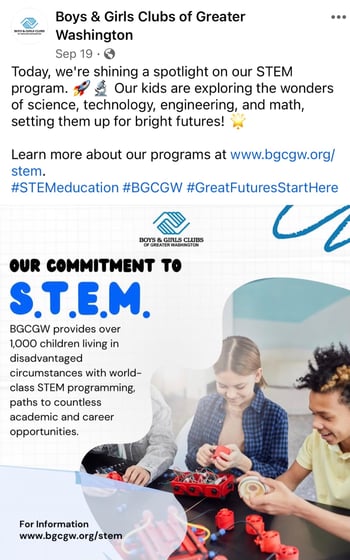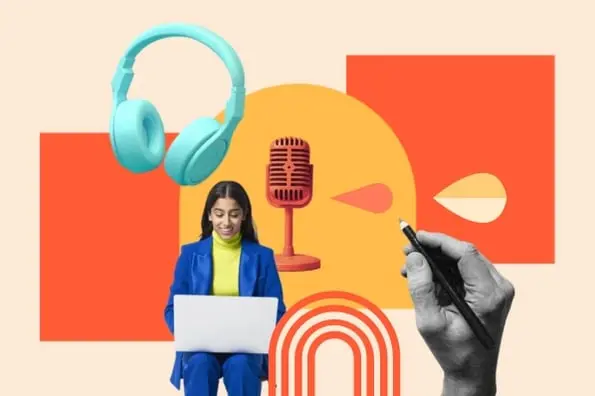“Whether you have a full-time staff member responsible for social media or someone that posts occasionally, I highly recommend having some kind of social presence — whatever that looks like.”

This advice comes from Terri Johnson, Director of Donor Relations & Special Events at the Boys & Girls Clubs of Greater Washington (BGCGW).
Johnson’s team wears many hats (as many nonprofit employees do), and that includes managing BGCGW’s social media strategy.
I thought she’d be the perfect person to ask how nonprofit organizations can tap into the power of social. Let’s take a look at her top tips.
Table of Contents
Why Social Media Matters for Nonprofits
Before we dive into the how, let’s talk about the why — why is it important for your nonprofit organization to be on social media?

For starters, we can look at the data: 55% of people who engage with nonprofits on social media end up taking some sort of action. This includes donating money, volunteering, or participating in community events.
I can actually speak to this personally.
I’m a big animal lover. I recently came across a post from The Humane Society on Instagram, and started scrolling through their feed.

Wow, they really do such great work for all types of animals, I thought to myself. So great in fact, it prompted me to make a donation to the cause.
Social media gives you the platform to:
- Generate awareness of your cause — Quickly meet your target audience where they are with information about your mission.
- Showcase your impact — Use this as an opportunity to highlight the meaningful work your organization does.
- Expand your fundraising efforts — Maximize the reach of your campaigns, and collect donations directly from the platforms.
It also doesn’t hurt that it’s free to get started. And when you do, here are 10 tips you should keep in mind.
Social Media Best Practices for Nonprofits
In an interview with Terri Johnson, BGCGW’s Director of Donor Relations & Special Events, we discussed some of her favorite social media best practices for nonprofits.

Let’s take a closer look at what she shared.
1. Figure out your social media goals.
Terri says, “It’s hard to measure success if you have nothing to compare it to.”
That’s why it’s important to set benchmarks for your social media activities. And from experience, I can confirm that this is true for all marketing efforts.
She adds “You can always map these goals back to your broader strategic objectives if you’re having trouble.” For example, use social media to support a larger fundraising or brand awareness target.
Bottom line: Set clear goals so you can quantify your social media work. That way you can assess whether the “juice really is worth the squeeze” (as they say).
2. Choose the right platforms.
As a nonprofit, your resources may be limited. Terri can “totally relate to this” as it wasn’t long ago that BGCGW had a similar challenge.
The good news is you don’t need to post on all platforms to make an impression.
In fact, Johnson suggests the following: “Make sure you understand which platforms are more popular with your target demographic.”
She continues, “At BGCGW, we use Instagram to appeal to our teen members and young professionals.”

“On Facebook, we like to focus on content that’s more relevant to parents and adults.”

And it’s true. Data says that 31% of Instagram users are ages 18-24. And 49% of Facebook users are ages 25-44.
Bottom line: Don’t feel like you need to be on every single channel as long as you’re meeting your audiences on the right ones.
3. Use visuals to tell your story.
For mission-driven organizations like nonprofits, a picture can certainly be worth a thousand words.
“Tell your story through imagery,” Terri suggests. “That’s what we do. Our mission is driven by the young people we support, so we like to highlight them on social media every chance we get.”
These are a few of my favorites from their Instagram feed:

Bottom line: Show people what your organization is all about and why they should invest in you.
4. Be genuine and use an authentic voice.
“Social media is a great way to show and tell — to give your target audience an inside view of your organization,” says Terri.
Authenticity is key if you want to tell your brand story in a compelling way and draw more supporters to your mission.
Johnson adds, “It allows you to showcase what makes you unique and can help separate you from the noise.”
Bottom line: Be honest, be real, and believe in what you say. If you can inspire trust, people are more likely to listen.
5. Build a community around your brand.
Your community on social media is more than just the audience you’re trying to reach. It includes your organization’s support system, too.
Terri says, “We like to mention our partners and sponsors as a way to shout them out while building brand recognition.”
“It also allows these companies and individuals to showcase their commitment to supporting our communities,” she adds.
Bottom line: Social media is meant to be social. Start conversations, interact with your followers, and give props to keep people engaged with your mission.
6. Leverage social media perks for nonprofits.
There are a number of social media resources to make it easy for nonprofits to promote their brand and meet their goals.
Here are two examples:
- Google Ad Grants for Nonprofits: Google offers free and discounted search ad credits for nonprofits. Terri noted that her team has tapped into this opportunity “multiple times” and seen positive results.
- Platform-Specific Tools: Most channels, including Facebook and Instagram, offer built-in fundraising tools for nonprofits. For example, you can easily add a “Support” button to your profile or a clickable “Donate” sticker to your Story.

Bottom line: Do the research to see what perks your brand can leverage, so you’re getting the most social media bang for your buck.
Alana’s Bonus Tip: Take advantage of AI writing tools.
AI isn’t perfect, but it can still save you time when it comes to content creation.
I’ve tried it out a few times, and it’s a great source of inspiration for me as a marketer.
I like to use conversational AI (e.g., ChatGPT) to generate topic and title ideas for blog posts and summarize long-form information into bite-sized nuggets for social.
These are a few social media writing prompts you can try out:
- "Create a post for Instagram promoting [insert event name and description] in [insert number] words or less."
- "Write a Facebook post summarizing our new initiative [insert initiative description]."
- “Draft a tweet asking for support for [insert cause description].”
HubSpot also has free AI tools available to help you draft compelling social copy.
Start Crushing Your Social Media Goals
Now is an excellent time to be social, especially for nonprofits.
Even if your strategy isn’t perfect or your resources are limited, you can always start small and refine things as you go.
In time, you’ll be well on your way to social media success.
![Download Now: Nonprofit Marketing & Fundraising Trends for 2022 [Free Report]](https://no-cache.hubspot.com/cta/default/53/6193b715-2ba9-4c6d-add0-681edfcae689.png)



![How Often Should You (or Your Company) Blog? [New Data]](https://blog.hubspot.com/hubfs/how%20often%20should%20you%20blog%20%28external%20research%29_featured.png)
![19 Types of Blogs that Make Money in 2024 [+Examples]](https://blog.hubspot.com/hubfs/blogs-Jan-05-2024-05-12-25-3281-PM.png)
![The Top 3 Reasons Consumers Read Blogs & How to Attract Them in 2024 [New Data]](https://blog.hubspot.com/hubfs/202_Reasons-Consumers-Read-Blogs.png)




